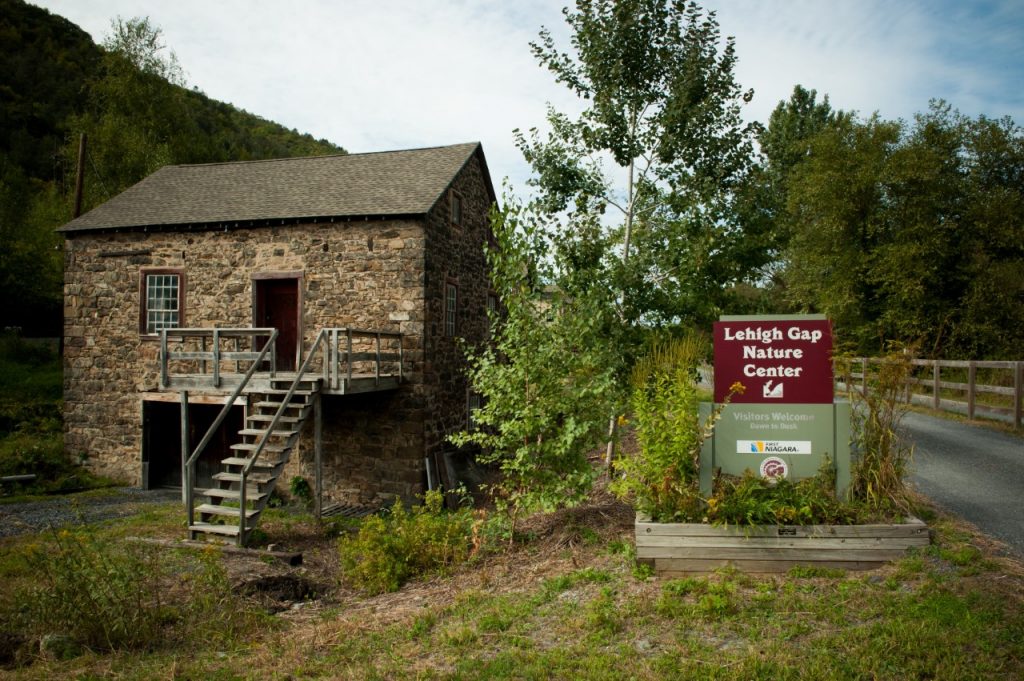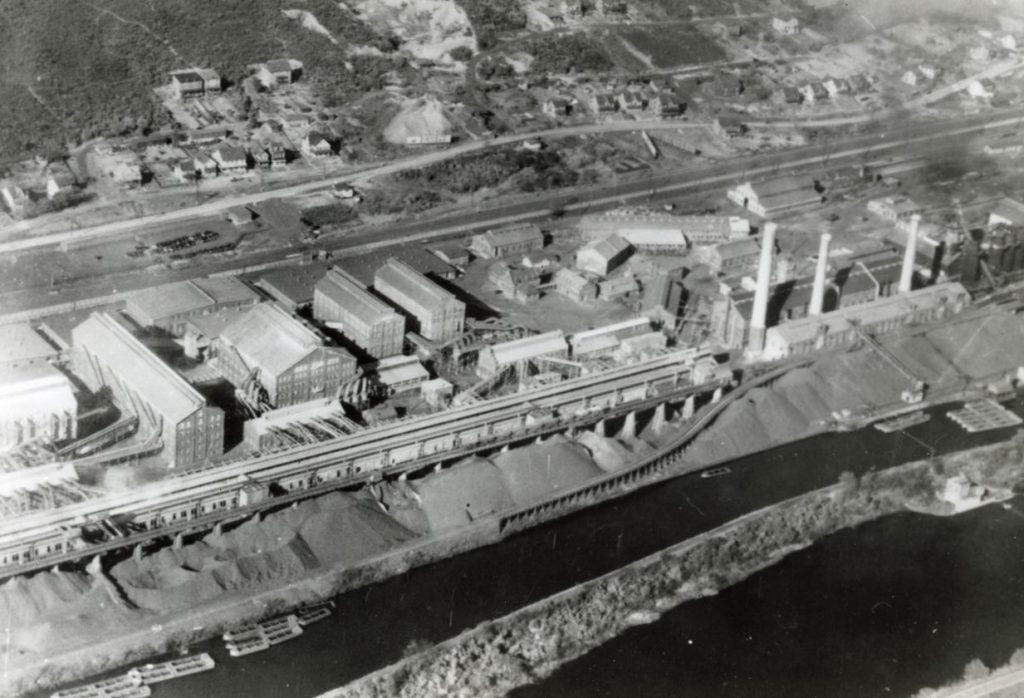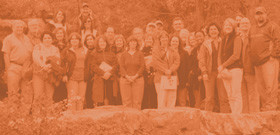The D&L Blog

Guest blog by Brian T. Birchak, Lehigh Gap Nature Center Director of Communications

Ah, the Lehigh Gap…I remember, as a child, having first laid eyes on the barren moonscape of a mountain it once was. I was young, about five years old. I didn’t understand why the mountain looked the way it did, but I was old enough to know what a Pennsylvania mountain was supposed to look like… and this wasn’t it. The mountain was basically dead, and looming over the town of Palmerton was the creepy Marshall’s Mansion on the blood red hill. No, I am not making this up. Dead mountain, check. Still-standing dead trees on mountain, check. Run down, big, scary, haunted mansion on a hill comprised of deep red rock…check.
We lived just outside of Palmerton, but had a Palmerton address and I went to the Palmerton schools. The Kittatinny and Lehigh Gap were in the backdrop of my entire childhood. It was an interesting time for Palmerton and an interesting time to grow up. The New Jersey Zinc Company (Horsehead Industries) was in its final stages of life and nothing but a faint shadow of its former self. Palmerton was literally built by the zinc company, for the zinc company’s employees.

I remember hearing people talking about newspaper articles detailing the fears of the town’s people. People were most afraid of Palmerton becoming a ghost town after the closing of the zinc company. The company wasn’t that bad to work for either (aside from all of the pollution). In fact, the zinc company was quite progressive in how it treated its employees. One can see how the citizens of Palmerton were unsure of the future of their town and were very loyal to the company that was a part of the town since before there was a town.
Many people believe the New Jersey Zinc Company was an evil entity that destroyed the area surrounding Palmerton. The people of Palmerton do not believe so. Yes, the devastation of the surrounding area was caused by the zinc smelting facilities, but was there any intent by the company to do this? No, there was not. The technology at the time did not allow for the more complete control of emissions that would have mitigated or even prevented the decimation of the surrounding area. The company actually lost a lot of revenue through their smokestacks in the form of zinc oxide. The New Jersey Zinc Company just did what other industries were, and still are, doing — and that’s creating a product to meet the demand.
We are paying the ecological price for our unfettered industrial explosion, which created many other negatively affected sites throughout the United States. A law was passed in 1980 that sought to clean up these sites. The Comprehensive Environmental Response, Compensation, and Liability Act (CERCLA) required the businesses responsible to pay for the cleanup of their Superfund areas. Palmerton and the surrounding area, under this law, became a Superfund site. I remember vividly how the federal Environmental Protection Agency (EPA) was not welcome by most people in town. There were many anti-EPA signs and stickers placed throughout the area. From what I can recall, the people of Palmerton were not very appreciative of the way the EPA came onto the scene to clean things up. This work, though important, was not tactfully done on the part of the EPA.
I graduated from Palmerton High School in 1997, and that autumn, I was living in Bethlehem for school. As I grew up in the area, the mountain was always dead. “Death Mountain,” “Skull Mountain,” and “Mars Mountain” were just a few of its nicknames, and it didn’t help that there is a rocky outcropping on the face of the mountain called the Devil’s Pulpit. The mountain was a destination for parties, a place for folks to practice their artistic skills (graffiti), or some off-roading on a four-wheeler or dirt bike. All of these activities not only worsened the reputation of the mountain, but they led to massive amounts of trash, erosion, and graffiti (which is still present to this day). Something needed to be done.

In 2001, I moved back to the area into my father’s house after he passed away. In a few years, many things in the area were changing. Trails were being built everywhere. Many of the old off-roading spots in the area were disappearing and turning in to hiking/biking trails. It was at this time that I began to notice some curious happenings in the Lehigh Gap. Things were changing. Things were growing! I remember seeing the crop-duster airplanes flying through the gap to seed some of its upper slopes. I didn’t hike the area or stop in to be nosey, but it was nice to see that someone was finally taking care of the mountain. I had not set foot on Lehigh Gap Nature Center property until the summer/autumn of 2007, when I participated in a college study within the Lehigh Gap Wildlife Refuge, which introduced me to the many corners of the property. The time I spent at the Refuge that summer reintroduced me to the history of the land I once called home.
I spent some time hiking around the Refuge and even included the Lehigh Gap in my list of regular hiking spots. I led hiking, backpacking, camping, and rock-climbing trips for an adjudicated youth camp in the Poconos, and I would take many groups from this camp through the Gap to teach them about what I learned from the time I spent on the Refuge. Dan Kunkle would usually be there. At this time, the new addition to the Osprey House was being constructed, so things were always a little busy. Dan was always very friendly and regularly offered my rag-tag group the opportunity to fill our very empty water bottles. I am so appreciative to have been able to refill my water bottle on those hot summer days.
Over the years, the Lehigh Gap Wildlife Refuge has become a spiritual place for me. The mountain has been there during the toughest and the best times in my life. That mountain has listened to me and healed me. I am not a religious person at all, but if someone were to ask where I go to church, I would tell them, “It’s a beautiful place where the Lehigh River carved a gap through the Kittatinny Ridge. Ya can’t miss it!” This is what the Lehigh Gap means to me.
About Lehigh Gap Nature Center
The Lehigh Gap Nature Center is a member-supported 501(c)3 non-profit conservation organization located in Lehigh Gap, PA, at the foot of the Kittatinny Ridge. Their mission is to protect the wildlife and enhance the habitats of the Refuge and the neighboring Kittatinny Ridge. They promote conservation in the Lehigh River Watershed through education, research, and outdoor recreation for the benefit of present and future generations. To date, the Lehigh Gap Nature Center is the only superfund site to have received an Environmental Protection Agency Award.












